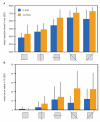Fluid intelligence allows flexible recruitment of the parieto-frontal network in analogical reasoning
- PMID: 21415916
- PMCID: PMC3049247
- DOI: 10.3389/fnhum.2011.00022
Fluid intelligence allows flexible recruitment of the parieto-frontal network in analogical reasoning
Abstract
Fluid intelligence is the ability to think flexibly and to understand abstract relations. People with high fluid intelligence (hi-fluIQ) perform better in analogical reasoning tasks than people with average fluid intelligence (ave-fluIQ). Although previous neuroimaging studies reported involvement of parietal and frontal brain regions in geometric analogical reasoning (which is a prototypical task for fluid intelligence), however, neuroimaging findings on geometric analogical reasoning in hi-fluIQ are sparse. Furthermore, evidence on the relation between brain activation and intelligence while solving cognitive tasks is contradictory. The present study was designed to elucidate the cerebral correlates of geometric analogical reasoning in a sample of hi-fluIQ and ave-fluIQ high school students. We employed a geometric analogical reasoning task with graded levels of task difficulty and confirmed the involvement of the parieto-frontal network in solving this task. In addition to characterizing the brain regions involved in geometric analogical reasoning in hi-fluIQ and ave-fluIQ, we found that blood oxygenation level dependency (BOLD) signal changes were greater for hi-fluIQ than for ave-fluIQ in parietal brain regions. However, ave-fluIQ showed greater BOLD signal changes in the anterior cingulate cortex and medial frontal gyrus than hi-fluIQ. Thus, we showed that a similar network of brain regions is involved in geometric analogical reasoning in both groups. Interestingly, the relation between brain activation and intelligence is not mono-directional, but rather, it is specific for each brain region. The negative brain activation-intelligence relationship in frontal brain regions in hi-fluIQ goes along with a better behavioral performance and reflects a lower demand for executive monitoring compared to ave-fluIQ individuals. In conclusion, our data indicate that flexibly modulating the extent of regional cerebral activity is characteristic for fluid intelligence.
Keywords: functional magnetic resonance imaging; geometric analogical reasoning; high fluid intelligence; parieto-frontal network; task difficulty.
Figures



Similar articles
-
Frontopolar cortex mediates abstract integration in analogy.Brain Res. 2006 Jun 22;1096(1):125-37. doi: 10.1016/j.brainres.2006.04.024. Epub 2006 Jun 5. Brain Res. 2006. PMID: 16750818 Clinical Trial.
-
Neural Correlates of Analogical Reasoning on Syntactic Patterns.J Cogn Neurosci. 2024 May 1;36(5):854-871. doi: 10.1162/jocn_a_02115. J Cogn Neurosci. 2024. PMID: 38307125
-
The role of fluid intelligence and learning in analogical reasoning: How to become neurally efficient?Neurobiol Learn Mem. 2016 Oct;134 Pt B:236-47. doi: 10.1016/j.nlm.2016.07.019. Epub 2016 Jul 25. Neurobiol Learn Mem. 2016. PMID: 27461735
-
The Neural Correlates of Analogy Component Processes.Cogn Sci. 2022 Mar;46(3):e13116. doi: 10.1111/cogs.13116. Cogn Sci. 2022. PMID: 35297092 Review.
-
The Parieto-Frontal Integration Theory (P-FIT) of intelligence: converging neuroimaging evidence.Behav Brain Sci. 2007 Apr;30(2):135-54; discussion 154-87. doi: 10.1017/S0140525X07001185. Epub 2007 Jul 26. Behav Brain Sci. 2007. PMID: 17655784 Review.
Cited by
-
Functional Near-Infrared Spectroscopy Recordings of Visuospatial Working Memory Processes. Part II: A Replication Study in Children on Sensitivity and Mental-Ability-Induced Differences in Functional Activation.Brain Sci. 2018 Aug 12;8(8):152. doi: 10.3390/brainsci8080152. Brain Sci. 2018. PMID: 30103538 Free PMC article.
-
Effective connectivity during episodic memory retrieval in schizophrenia participants before and after antipsychotic medication.Hum Brain Mapp. 2015 Apr;36(4):1442-57. doi: 10.1002/hbm.22714. Epub 2014 Dec 11. Hum Brain Mapp. 2015. PMID: 25504918 Free PMC article. Clinical Trial.
-
Individual differences in reasoning and visuospatial attention are associated with prefrontal and parietal white matter tracts in healthy older adults.Neuropsychology. 2016 Jul;30(5):558-67. doi: 10.1037/neu0000264. Epub 2016 Mar 17. Neuropsychology. 2016. PMID: 26986750 Free PMC article.
-
Neuromodulatory effects of parietal high-definition transcranial direct-current stimulation on network-level activity serving fluid intelligence.J Physiol. 2024 Jun;602(12):2917-2930. doi: 10.1113/JP286004. Epub 2024 May 17. J Physiol. 2024. PMID: 38758592 Free PMC article.
-
Making cognitive latent variables manifest: distinct neural networks for fluid reasoning and processing speed.J Cogn Neurosci. 2015 Jun;27(6):1249-58. doi: 10.1162/jocn_a_00778. Epub 2014 Dec 24. J Cogn Neurosci. 2015. PMID: 25539045 Free PMC article.
References
-
- Ackerman P. L., Beier M. E., Boyle M. O. (2005). Working memory and intelligence: the same or different constructs? Psychol. Bull. 131, 30–60 - PubMed
-
- Allman J. M., Hakeem A., Erwin J. M., Nimchinsky E., Hof P. (2001). The anterior cingulate cortex. Ann. N. Y. Acad. Sci. 935, 107–117 - PubMed
-
- Bethell-Fox C. E., Lohmann D. F., Snow R. E. (1984). Adaptive reasoning: componential and eye movement analysis of geometric analogy performance. Intelligence 8, 205–23810.1016/0160-2896(84)90009-6 - DOI
-
- Boroojerdi B., Phipps M., Kopylev L., Wharton C. M., Cohen L. G., Grafman J. (2001). Enhancing analogic reasoning with rTMS over the left prefrontal cortex. Neurology 56, 526–528 - PubMed
LinkOut - more resources
Full Text Sources

